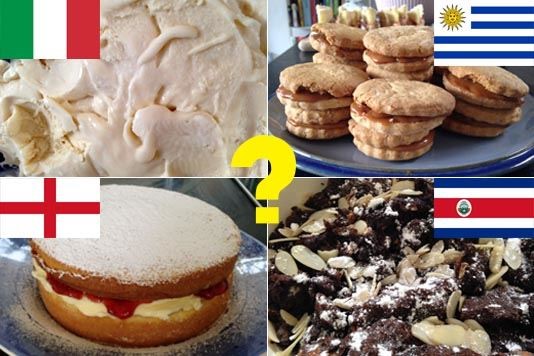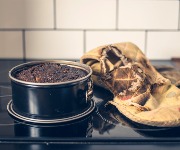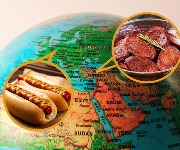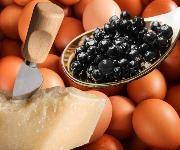The World Cup of puddings: who will taste sweet victory?

If England, Italy, Uruguay and Costa Rica had a food battle instead of a football one, who would win? We took to the kitchen to find out.
Encouraged by World Cup hysteria, team lovefood decided to run a little tournament of its own. So for each team in our World Cup group, we baked a sweet treat traditional to that country and then invited the office to taste and pass judgement on all four. Would England rise to the occasion and come top of the table?
The contenders
England
 The only criteria was that the dish be a sweet one, and as traditional to the nation in question as possible. So for England it had to be a Victoria sponge cake – a simple recipe, but one that makes such beautiful sense. I’ve been baking them since I was eight, and despite baking every cake under the sun since then, Victoria sponge is still my favourite.
The only criteria was that the dish be a sweet one, and as traditional to the nation in question as possible. So for England it had to be a Victoria sponge cake – a simple recipe, but one that makes such beautiful sense. I’ve been baking them since I was eight, and despite baking every cake under the sun since then, Victoria sponge is still my favourite.
You all know the drill: blitz sugar, butter, eggs and flour (200g of each) together to make a light batter that just plops off a spoon, then bake for 20 minutes. Easy peasy. I filled my sponge with buttercream and jam, because that’s how we’ve always eaten it at home.
Italy
 Having just been delivered a state-of-the-art ‘gelato and ice cream maker’ by Cuisinart (look out for it in a future gadget test), we decided to make a batch of vanilla gelato to represent Italy. It involved combining milk, cream, cornstarch, sugar, vanilla extract and pectin over a heat, refrigerating the mix overnight, and then churning it in the machine for 40 minutes the next day. It worked like a dream, and made better gelato than we’ve eaten in some places in Italy itself.
Having just been delivered a state-of-the-art ‘gelato and ice cream maker’ by Cuisinart (look out for it in a future gadget test), we decided to make a batch of vanilla gelato to represent Italy. It involved combining milk, cream, cornstarch, sugar, vanilla extract and pectin over a heat, refrigerating the mix overnight, and then churning it in the machine for 40 minutes the next day. It worked like a dream, and made better gelato than we’ve eaten in some places in Italy itself.
Gelato is actually very different to ice cream – it has less fat in it (using more milk than cream), and tends to be churned at a steadier pace than ice cream, making it denser than its English counterpart.
Uruguay
 Uruguay was represented by ‘Alfajores’: two round biscuits sandwiched together by that South American delight, dulce de leche. The biscuits themselves were soft, delicate and crumbly and not overly sweet, which makes them the perfect carrier for a great big splodge of super sweet dulce de leche in the middle.
Uruguay was represented by ‘Alfajores’: two round biscuits sandwiched together by that South American delight, dulce de leche. The biscuits themselves were soft, delicate and crumbly and not overly sweet, which makes them the perfect carrier for a great big splodge of super sweet dulce de leche in the middle.
To make the biscuit dough, you combine all the usual suspects together (sugar, butter, salt, eggs) but instead of regular flour you use cornflour. It’s this that gives Alfajores their distinctively delicate crumble. The resulting dough is yellow in colour (there’s quite a lot of egg yolk in there) and takes less than 10 minutes to crisp up in the oven. We loved sandwiching two biscuits together.
Costa Rica
 It proved difficult to find a worthy Costa Rican pudding – perhaps it’s just too hot out there to even consider dessert. But eventually we came up with ‘Capirotada’, a kind of chocolate bread and butter pudding made with egg bread, albeit one usually associated with Mexico. This food blogger made it look very delicious indeed.
It proved difficult to find a worthy Costa Rican pudding – perhaps it’s just too hot out there to even consider dessert. But eventually we came up with ‘Capirotada’, a kind of chocolate bread and butter pudding made with egg bread, albeit one usually associated with Mexico. This food blogger made it look very delicious indeed.
To make it, you cube and toast the egg bread (we used brioche), then make a chocolatey mix from warm milk, bittersweet chocolate and cinnamon. Add this to a whisked mix of egg yolks and sugar, then pour the whole lot over your brioche cubes. Let it stand for half an hour, then transfer the sludgy mixture into a buttered casserole dish. Bake sat in a water bath for 20 minutes, then serve warm, scattered with almonds. Suffice to say, although it smelled great, Capirotada was probably the least attractive pudding of the line-up.
The results
We had four very different sweet treats in the line-up, and just shy of 20 people trying them all. It was the busiest our kitchen has ever been! Tasters were simply asked to mark each offering out of 10. Every pudding was well received – we had people coming back for seconds of all of them. But who won? Here's how our leaderboard looked.
|
Country |
Sweet treat |
Point average (/10) |
|
England |
Victoria sponge |
8.7 |
|
Uruguay |
Alfajores |
8.5 |
|
Italy |
Vanilla gelato |
8.1 |
|
Costa Rica |
Capirotada |
6.8 |
4th: Costa Rica
Our Capirotada scored a respectable 6.8/10, with people enjoying its soft texture and chocolatey aftertaste. Someone gave it 10/10, and another couple scored it 9. The appearance and slight crust on top put a few off, but underneath all that it was a decadent, hug-in-a-bowl treat.
3rd: Italy
A surprise result for Italy, considering how sensational the gelato was. But it seems most of our tasters wanted something solid to eat as opposed to a nice scoop of gelato to lick. It still scored 8.1/10 though.
2nd: Uruguay
Our Alfajores were hugely popular. The light, crumbly biscuit is a perfect match for something as sweet as dulce de leche, and they look great too. No-one had tried them before, and I got four requests for the recipe. It scored 8.5/10.
1st: England
Sweet victory! Literally. If only the World Cup was decided by a country’s food culture. It’s very, very hard to beat Victoria sponge, if it’s made correctly and served the same day as baking. The key to an excellent Victoria sponge is to beat the batter well, until it’s light in colour and creamy in texture. There’s also no need to sift the flour in my opinion (controversial, I know).
So Victoria sponge comes top of the table with a score of 8.7/10 – just 0.2 marks higher than Uruguay and its Alfajores. The video below shows you how to make your own champion cake to eat while you watch the footie.
Let’s hope that our foodie test reflects what will happen on the football pitch!
Have you tried any of the sweet treats we made? Which do you think should have won? And was Victoria sponge a good choice for England? Share your thoughts in the Comments box below.
You might also like
Theme park food: France v England
The history of Bakewell Pudding, and how to make one
Poll: can English sparkling wine ever compete with Champagne?
Most Recent
Comments
Be the first to comment
Do you want to comment on this article? You need to be signed in for this feature








